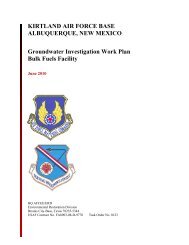Final FONSI and EA for hot cargo pad on Kirtland AFB - Kirtland Air ...
Final FONSI and EA for hot cargo pad on Kirtland AFB - Kirtland Air ...
Final FONSI and EA for hot cargo pad on Kirtland AFB - Kirtland Air ...
Create successful ePaper yourself
Turn your PDF publications into a flip-book with our unique Google optimized e-Paper software.
<str<strong>on</strong>g>Final</str<strong>on</strong>g> <str<strong>on</strong>g>EA</str<strong>on</strong>g> Addressing C<strong>on</strong>structi<strong>on</strong>, Operati<strong>on</strong>, <str<strong>on</strong>g>and</str<strong>on</strong>g> Maintenance of a Hot Cargo Pad<br />
capacity over the amount approved in its 1998 New Mexico Envir<strong>on</strong>ment Department permit (Permit<br />
Number 231402), but anticipates closure in 2019 (Waste Management 2010, NMED undated). From<br />
2007 to 2009, Kirtl<str<strong>on</strong>g>and</str<strong>on</strong>g> <strong>AFB</strong> sent an average of 2,500 t<strong>on</strong>s of solid waste per year to the City of Rio<br />
Rancho l<str<strong>on</strong>g>and</str<strong>on</strong>g>fill (Kitt 2010). Kirtl<str<strong>on</strong>g>and</str<strong>on</strong>g> <strong>AFB</strong> operates a c<strong>on</strong>structi<strong>on</strong>-<str<strong>on</strong>g>and</str<strong>on</strong>g>-demoliti<strong>on</strong>-<strong>on</strong>ly l<str<strong>on</strong>g>and</str<strong>on</strong>g>fill <strong>on</strong> the<br />
installati<strong>on</strong>. This l<str<strong>on</strong>g>and</str<strong>on</strong>g>fill accepts <strong>on</strong>ly c<strong>on</strong>structi<strong>on</strong> <str<strong>on</strong>g>and</str<strong>on</strong>g> demoliti<strong>on</strong> waste from permitted c<strong>on</strong>tractors<br />
working <strong>on</strong> the installati<strong>on</strong>. The maximum capacity of the Kirtl<str<strong>on</strong>g>and</str<strong>on</strong>g> <strong>AFB</strong> l<str<strong>on</strong>g>and</str<strong>on</strong>g>fill is 10,164,000 cubic<br />
yards (4,065,676 t<strong>on</strong>s) <str<strong>on</strong>g>and</str<strong>on</strong>g> the remaining capacity is 5,017,316 cubic yards (2,006,964 t<strong>on</strong>s). From 2007<br />
to 2009, Kirtl<str<strong>on</strong>g>and</str<strong>on</strong>g> <strong>AFB</strong> disposed of an average of 23,000 t<strong>on</strong>s per year of c<strong>on</strong>structi<strong>on</strong> <str<strong>on</strong>g>and</str<strong>on</strong>g> demoliti<strong>on</strong><br />
waste at the <strong>on</strong>-installati<strong>on</strong> l<str<strong>on</strong>g>and</str<strong>on</strong>g>fill (Kitt 2010). Kirtl<str<strong>on</strong>g>and</str<strong>on</strong>g> <strong>AFB</strong> manages a recycling program to reduce the<br />
amount of solid waste sent to l<str<strong>on</strong>g>and</str<strong>on</strong>g>fills. The Kirtl<str<strong>on</strong>g>and</str<strong>on</strong>g> <strong>AFB</strong> Qualified Recycling Program is operated by<br />
c<strong>on</strong>tractors <str<strong>on</strong>g>and</str<strong>on</strong>g> collects office paper, cardboard, <str<strong>on</strong>g>and</str<strong>on</strong>g> aluminum from pick-up points scattered across the<br />
installati<strong>on</strong> (K<strong>AFB</strong> 2002). Additi<strong>on</strong>al recycling ef<str<strong>on</strong>g>for</str<strong>on</strong>g>ts are oftentimes included in specific c<strong>on</strong>structi<strong>on</strong><br />
<str<strong>on</strong>g>and</str<strong>on</strong>g> demoliti<strong>on</strong> projects.<br />
3.10 Hazardous Materials <str<strong>on</strong>g>and</str<strong>on</strong>g> Waste<br />
3.10.1 Definiti<strong>on</strong> of the Resource<br />
Hazardous materials are defined by 49 CFR 171.8 as “hazardous substances, hazardous wastes, marine<br />
pollutants, elevated temperature materials, materials designated as hazardous in the Hazardous Materials<br />
Table (49 CFR 172.101), <str<strong>on</strong>g>and</str<strong>on</strong>g> materials that meet the defining criteria <str<strong>on</strong>g>for</str<strong>on</strong>g> hazard classes <str<strong>on</strong>g>and</str<strong>on</strong>g> divisi<strong>on</strong>s” in<br />
49 CFR 173. Transportati<strong>on</strong> of hazardous materials is regulated by the U.S. Department of<br />
Transportati<strong>on</strong> regulati<strong>on</strong>s within 49 CFR 105–180.<br />
Hazardous wastes are defined by the Resource C<strong>on</strong>servati<strong>on</strong> <str<strong>on</strong>g>and</str<strong>on</strong>g> Recovery Act (RCRA) at 42 U.S.C.<br />
6903(5), as amended by the Hazardous <str<strong>on</strong>g>and</str<strong>on</strong>g> Solid Waste Amendments, as: “a solid waste, or combinati<strong>on</strong><br />
of solid wastes, which because of its quantity, c<strong>on</strong>centrati<strong>on</strong>, or physical, chemical, or infectious<br />
characteristics may (A) cause, or significantly c<strong>on</strong>tribute to an increase in mortality or an increase in<br />
serious irreversible, or incapacitating reversible, illness; or (B) pose a substantial present or potential<br />
hazard to human health or the envir<strong>on</strong>ment when improperly treated, stored, transported, or disposed of,<br />
or otherwise managed.” Certain types of hazardous wastes are subject to special management provisi<strong>on</strong>s<br />
intended to ease the management burden <str<strong>on</strong>g>and</str<strong>on</strong>g> facilitate the recycling of such materials. These are called<br />
universal wastes <str<strong>on</strong>g>and</str<strong>on</strong>g> their associated regulatory requirements are specified in 40 CFR 273. Four types of<br />
waste are currently covered under the universal waste regulati<strong>on</strong>s: hazardous waste batteries, hazardous<br />
waste pesticides that are either recalled or collected in waste pesticide collecti<strong>on</strong> programs, hazardous<br />
waste thermostats, <str<strong>on</strong>g>and</str<strong>on</strong>g> hazardous waste lamps.<br />
Special hazards are those substances that might pose a risk to human health <str<strong>on</strong>g>and</str<strong>on</strong>g> are addressed separately<br />
from other hazardous substances. Special hazards include ACM, polychlorinated biphenyls (PCBs), <str<strong>on</strong>g>and</str<strong>on</strong>g><br />
lead-based paint (LBP). The USEPA is given authority to regulate these special hazard substances by the<br />
Toxic Substances C<strong>on</strong>trol Act (TSCA) Title 15 U.S.C. Chapter 53. TSCA Subchapter I identifies PCBs,<br />
Subchapter II ACMs <str<strong>on</strong>g>and</str<strong>on</strong>g> Subchapter IV LBP. The USEPA has established regulati<strong>on</strong>s regarding asbestos<br />
abatement <str<strong>on</strong>g>and</str<strong>on</strong>g> worker safety under 40 CFR 763 with additi<strong>on</strong>al regulati<strong>on</strong> c<strong>on</strong>cerning emissi<strong>on</strong>s (40 CFR<br />
61). Whether from lead abatement or other activities, depending <strong>on</strong> the quantity or c<strong>on</strong>centrati<strong>on</strong> the<br />
disposal of the LBP waste is potentially regulated by the RCRA at 40 CFR 260. The disposal of PCBs is<br />
addressed in 40 CFR 750 <str<strong>on</strong>g>and</str<strong>on</strong>g> 761. The presence of special hazards or c<strong>on</strong>trols over them might affect, or<br />
be affected by, a proposed acti<strong>on</strong>. In<str<strong>on</strong>g>for</str<strong>on</strong>g>mati<strong>on</strong> <strong>on</strong> special hazards describing their locati<strong>on</strong>s, quantities,<br />
<str<strong>on</strong>g>and</str<strong>on</strong>g> c<strong>on</strong>diti<strong>on</strong> assists in determining the significance of a proposed acti<strong>on</strong>.<br />
The DOD has developed the ERP, which facilitates envir<strong>on</strong>mentally resp<strong>on</strong>sible l<str<strong>on</strong>g>and</str<strong>on</strong>g> management<br />
through investigati<strong>on</strong> <str<strong>on</strong>g>and</str<strong>on</strong>g> cleanup of c<strong>on</strong>taminated sites <strong>on</strong> military installati<strong>on</strong>s. Through the ERP, the<br />
Kirtl<str<strong>on</strong>g>and</str<strong>on</strong>g> <strong>AFB</strong>, NM January 2011<br />
3-32
















